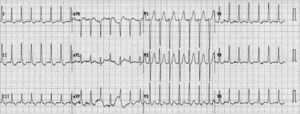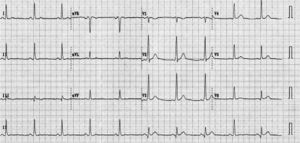A Narrow QRS Complex Tachycardia Sensitive to Isoptin: Difference between revisions
Jump to navigation
Jump to search
m (New page: {{NHJ| |mainauthor= '''A.A.M. Wilde, R.H. Bakker''' |edition= 2006,08:268 }} Figure 1|thumb Figure 2|thumb A 54...) |
|||
| (9 intermediate revisions by 2 users not shown) | |||
| Line 16: | Line 16: | ||
[[Puzzle_2006_08_268 Answer|Answer]] | [[Puzzle_2006_08_268 Answer|Answer]] | ||
Latest revision as of 19:26, 30 December 2010
| Author(s) | A.A.M. Wilde, R.H. Bakker | |
| NHJ edition: | 2006,08:268 | |
| These Rhythm Puzzles have been published in the Netherlands Heart Journal and are reproduced here under the prevailing creative commons license with permission from the publisher, Bohn Stafleu Van Loghum. | ||
| The ECG can be enlarged twice by clicking on the image and it's first enlargement | ||
A 54-year-old man presented with palpitations. He had no other symptoms. Physical examination revealed, with the exception of a fast regular heart rhythm (200 beats/min), no abnormalities. His ECG is shown in figure 1. Intravenous verapamil terminated the tachycardia and a second ECG (figure 2) was taken.
What is your diagnosis?

